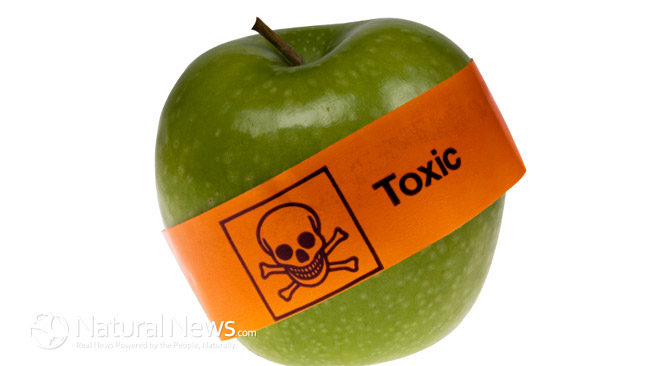What is a pesticide?
A pesticide is a mixture of chemical substances used on farms to destroy or prevent pests, diseases and weeds from affecting crops. According to the USDA, 45 percent of the world’s crops are lost to damage or spoilage, so many farmers count on pesticides.
If you’re eating non-organic celery today, you may be ingesting 67 pesticides with it, according to a new report from the Environmental Working Group.
The group, a nonprofit focused on public health, scoured nearly 100,000 produce pesticide reports from the U.S. Department of Agriculture and the U.S. Food and Drug Administration to determine what fruits and vegetables we eat have the highest, and lowest, amounts of chemical residue.
Some highlights from the report:
A single grape sample contained 15 pesticides.
The average potato had more pesticides by weight than any other food.
Single samples of celery, cherry tomatoes, imported snap peas and strawberries showed 13 different pesticides apiece.
When it comes to pesticides, fungicides, and other chemicals, all crops are by no means equal. (i)
If you want to buy organic but have budget constraints, you can prioritize by buying organic versions of the “dirty dozen”
12 fruits and vegetables that have the highest pesticide residues:
Apples
Pesticides cling to apple skin, and can be absorbed into the flesh beneath. Wash fruit thoroughly, and peel before eating.
Strawberries
Strawberries are the most chemical-intensive crop in California, and those grown in South America may be laden with even more, as restrictions aren’t as severe in developing countries. Some organic growers apparently joke that conventionally grown strawberries can be ground up and used as pesticides themselves, since they’re so contaminated. (ii)
Grapes
Would you believe that a single grape tested positive for 15 pesticides? Perhaps the most serious is chlorpyrifos, an insecticide known to sicken farmworkers and others living or working close to fields. Immediate exposure to chlorpyrifos causes coughing, shortness of breath, headache, nausea, dizziness, and disorientation.
Celery
An average of 64 difficult-to-wash-away chemicals can be found on any given bunch of celery, and considering that celery is basically a water-uptake plant that draws liquids (and toxins) from the soil, do you really want to think about what might be running through your veins after you’ve eaten a stalk or two?
Peaches
If you love peaches, go for canned instead of fresh. These luscious globes are right behind celery as far as toxin levels go. (iii)
Spinach
Spinach is so prone to insect nibbling that conventional farmers have to douse it in (carcinogenic!) chemicals just to keep the bugs off. Guess what gets absorbed into each and every leaf?
Sweet bell peppers
Residues of 15 pesticides were found on bell peppers, among them neurotoxic neonicotinoids, which harm bee colonies as well as people.
Nectarines
These peachy cousins are just as coated with chemicals, and have even thinner skins to absorb them through.
Cucumbers
Among the 86 pesticides found on cucumbers were neurotoxins, suspected hormone disruptors, and probable carcinogens. Of particular concern is carbendazim, a fungicide that’s considered a probable carcinogen. Carbendazim has been turning up in orange juice and many other food products, prompting FDA consumer health warnings. (iv)
Tomatoes
The leaves and vines of tomato plants contain alkaloid poisons such as atropine that cause dizziness, headaches and upset tummies. There is also some in green tomatoes and one death has been attributed to it, but generally the amount of ‘tomatine’ in them is too small to cause any harm. Always refuse tea made from the leaves though; it is still something offered on occasion.
Pears
Like apples, these fruits are sprayed constantly to get rid of mites, aphids, moth eggs, and countless other critters.
Potatoes
Potatoes are perfectly safe unless they have turned green on the skins or are sprouting. They contain solanine, which develops with exposure to light – one reason to always keep potatoes in a cool, dark place. If you eat too much, you will experience severe digestive problems or even death.
Can pesticides be washed away?
Not necessarily. The pesticide tests mentioned above were conducted after the food had been power-washed by the USDA. Also, although some pesticides are found on the surface of foods, other pesticides may be taken up through the roots and into the plant and cannot be removed.
All fresh produce, whether it’s grown with or without pesticides, should be washed with water to remove dirt and potentially harmful bacteria. And health experts agree that when it comes to the Dirty Dozen list, choose organic if it’s available. (v)
Read More
Over The Counter Painkillers or Just Pain Killers? 14 Natural Alternative!
7 Silent Diabetes Complications: Use These 2 Drink To Reverse Naturally
14 Natural Home Remedies for Yellow Teeth Without Toxic Fluoride






